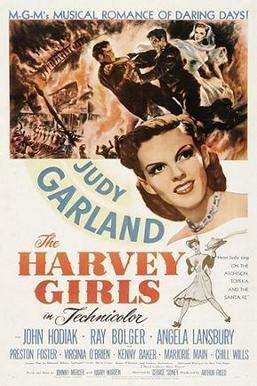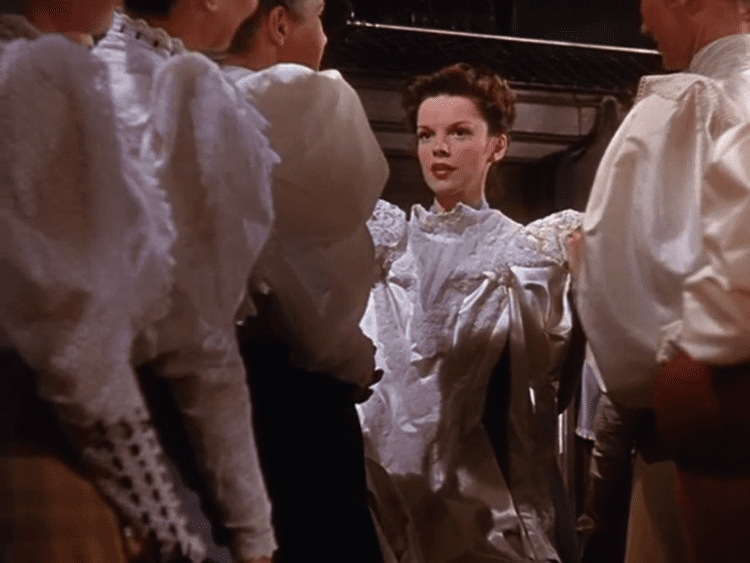The Harvey Girls
6 /10 1 Votes6
Duration Language English | Country United States | |||||||||||||||||||||||||||||||||
 | ||||||||||||||||||||||||||||||||||
Director George SidneyRobert Alton (musical number) Release date January 18, 1946 (1946-01-18) (U.S.) | ||||||||||||||||||||||||||||||||||
The Harvey Girls is a 1946 MGM musical film based on the 1942 novel of the same name by Samuel Hopkins Adams, about Fred Harvey's famous Harvey House waitresses. Directed by George Sidney, the film stars Judy Garland and features John Hodiak, Ray Bolger, and Angela Lansbury, as well as Preston Foster, Virginia O'Brien, Kenny Baker, Marjorie Main and Chill Wills. Future star Cyd Charisse appears in her first film speaking role on film.
Contents
- Scary movie 3 11 11 movie clip down the well 2003 hd
- Plot
- Cast
- Production
- Songs
- Deleted songs
- Critical response
- Box office
- Awards and honors
- The harvey girls 1946 official trailer judy garland movie
- References

The Harvey Girls won an Academy Award for Best Song for "On the Atchison, Topeka, and the Santa Fe", written by Harry Warren and Johnny Mercer. The film was a production of the Arthur Freed unit at MGM.
Scary movie 3 11 11 movie clip down the well 2003 hd
Plot
In the 1890s, a group of "Harvey Girls" – new waitresses for Fred Harvey's pioneering chain of Harvey House restaurants – travels on the Atchison, Topeka & Santa Fe Railway (AT&SF) to the western town of Sandrock, Arizona. On the trip they meet Susan Bradley (Judy Garland), who travels to the same town to marry the man whose beautiful letters she received when she answered a "lonely-hearts" ad. Unfortunately, when she arrives, the man turns out to be an "old coot" who does not at all meet her expectations – and he also wants not to get married as much as she wants not to marry him, so they agree to call it off. When she learns that someone else, the owner of the local saloon, Ned Trent (John Hodiak), wrote the letters as a joke, she confronts him and tells him off, in the process endearing herself to him.
Then Susan joins the Harvey Girls, and she soon becomes their leader in fighting against the attempts by Trent's business associate, Judge Sam Purvis (Preston Foster), to scare them off – and against the animosity of the dance-hall girls and, apparently, prostitutes, led by Em (Angela Lansbury), who is in love with Trent, and who sees Susan as a rival. Trent visits to see the value of the Harvey House and other trappings of civilization, then he tells Purvis to leave them alone, but Purvis continues with his campaign of intimidation, finally burning down the restaurant. Trent offers his saloon as a replacement, and Em and the dance-hall girls leave town. Susan, thinking that Trent too is leaving, gets on the train, but Em, seeing that Susan loves Trent so much that she is willing to give up everything for him, stops the train and points out Trent, riding toward them on his horse. Ultimately, they are wedded in the desert, surrounded by the Harvey Girls.
Cast
Cast notes:
Production
The Harvey Girls was conceived by MGM as a dramatic vehicle for Lana Turner, but Roger Edens, of the Arthur Freed unit, decided after seeing the musical Oklahoma! that the story should be reworked as MGM's western musical with Judy Garland as its star. Unfortunately, Garland wanted to work with Fred Astaire on Yolanda and the Thief, which was directed by fiance Vincente Minnelli. Edens convinced her that the part in Yolanda was not large enough for her, and he promised that The Harvey Girls would be specifically created to showcase her talents. Ann Sothern and Lucille Ball were slated to have roles in the film, and Edward Arnold was scheduled to play the role of Judge Purvis.
The Harvey Girls filmed from January 12 through June 4, 1945, a long production period. Studio filming was at MGM's Culver City studios, and location shooting took place in Victorville, California; at the Iverson Ranch in Chatsworth (near Los Angeles); and in Monument Valley.
Although Angela Lansbury was a fine singer, her voice was considered unsuitable for her character, a low-class saloon singer. Virginia Rees provided Lansbury's singing voice. Cyd Charisse, who had her first speaking role in the film, also had her singing dubbed by Marion Doenges.
Virginia O'Brien, a comic actress known for her deadpan style of singing, was pregnant while The Harvey Girls was filmed. Several scenes with Ray Bolger were never filmed due to the difficulty in hiding her pregnancy. This accounts for O'Brien's character disappearing after O'Brien sings "Wild Wild West". Bolger also sustained a burn injury by steam during the filming of "On the Atchison, Topeka, and the Santa Fe".
The Harvey Girls was released in the U.S. on January 18, 1946.
Production credits:
Songs
The songs in The Harvey Girls were all written by Harry Warren (music) and Johnny Mercer (lyrics):
By far the biggest hit from the score of The Harvey Girls was "On the Atchison, Topeka, and the Santa Fe". MGM released the song to record companies even before shooting was finished on the film, and it became an instant hit dominating the airwaves through the summer and fall of 1945, with versions by Bing Crosby with Six Hits and a Miss, Judy Garland and The Merry Macs, the Tommy Dorsey Orchestra with the Sentimentalists, and, the most popular, Johnny Mercer and The Pied Pipers. Mercer's version entered the Billboard charts on July 5, 1945, and stayed on it for 16 weeks, including seven straight weeks as #1 between July 28 and September 8. Crosby's entered the charts on July 19 and stayed ten weeks, going as high as #4, while Dorsey's entered on August 2 and stayed for six weeks, peaking at #6. Garland's hit the Billboard #10 position on September 20. The song was also number 1 on Your Hit Parade for eight weeks running.
In shooting the number for the film, Garland reportedly did the entire song up to the tempo change in one take, twice, after watching her stand-in do one run-through.
Deleted songs
Cut from the film were three other songs written for it by Warren and Mercer: "March of the Doagies," "Hayride" and "My Intuition." "Doagies" was a production number featuring Garland; this video outtake was included in That's Entertainment! III (1994). "My Intuition" was a duet for Garland and John Hodiak; this was also filmed and still survives in video format. "Hayride", sung by Garland, was prerecorded but not filmed.
Critical response
Howard Barnes wrote in the New York Herald Tribune that the film was "A great big animated picture postcard. Judy Garland is the film's bright ... star. Miss Garland is effectively glamorized in get-ups of the (18)90's and sings her songs pleasantly. The Harvey Girls is a perfect demonstration of what Hollywood can do with its vast resources when it wants to be really showy ... pretty girls – period sets and costumes – lilting tunes – super-speedy dance shuffles."
The New York Daily News said it was "A nostalgic whiff of the old west. Judy sings several sentimental ballads, as well as On the Atchison, Topeka, and the Santa Fe number. Her chief support in the way of real entertainment comes from Ray Bolger." Time wrote "A technicolored musical celebrating the coming of chastity, clean silverware, and crumbless tablecloths to the pioneer Southwest. The bearers of this culture, according to evidence presented here, were waitresses. The Harvey Girls is good fun in spots. Miss Garland doesn't seem as recklessly happy as she was in St. Louis but she still appears to be having a pretty fine time."
Box office
According to MGM records the film earned $4,112,000 in the US and Canada and $1,063,000.
Awards and honors
"On the Atchison, Topeka, and the Santa Fe" won an Academy Award for Best Original Song for Harry Warren and Johnny Mercer. In addition, Lennie Hayton's score was nominated for Best Music, Scoring of a Musical Picture, but did not win.
The film is recognized by American Film Institute in these lists:
